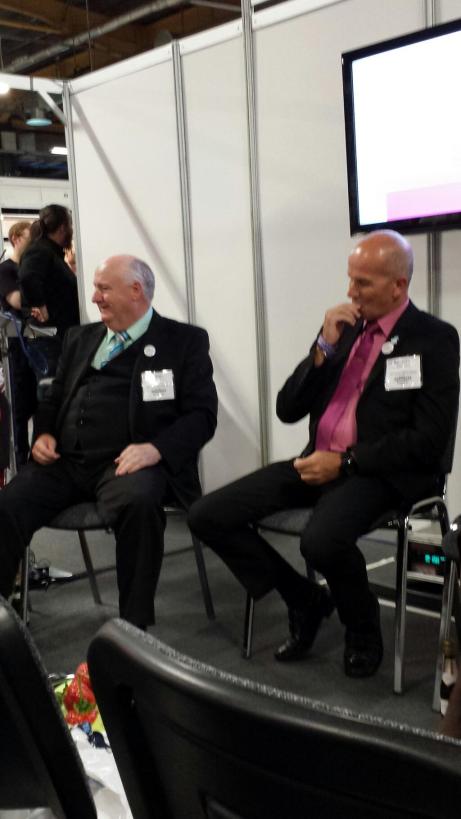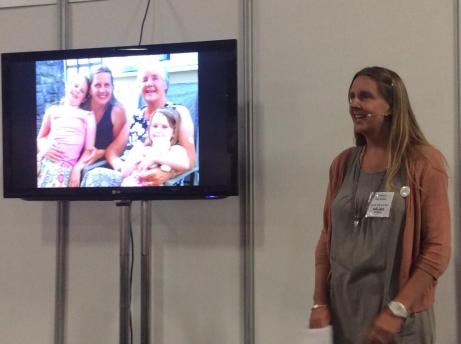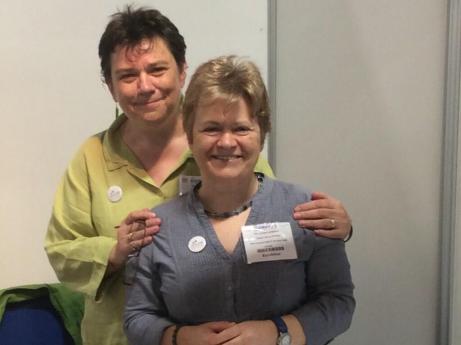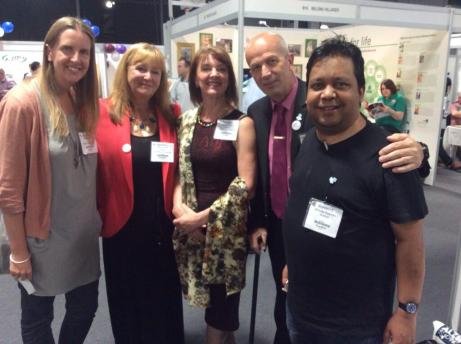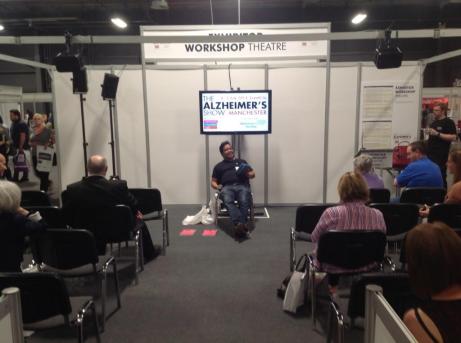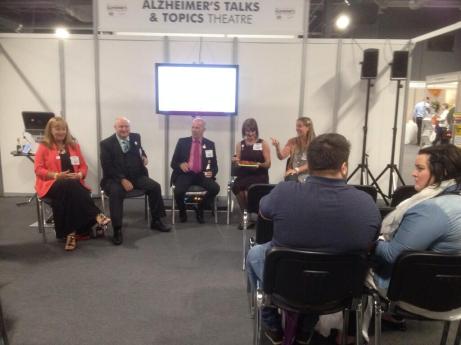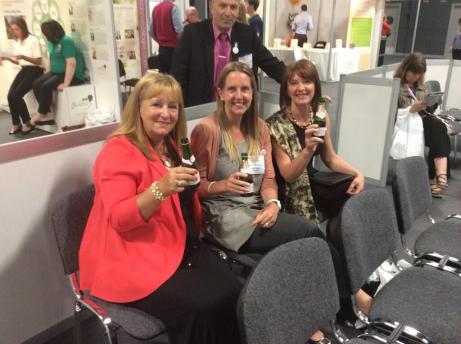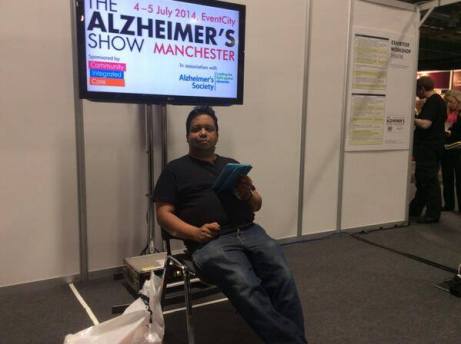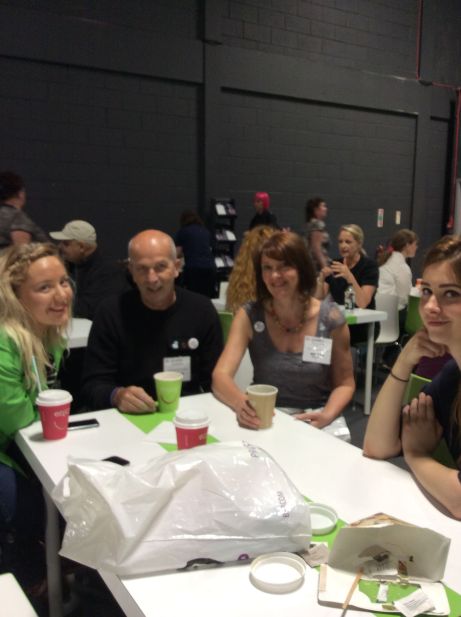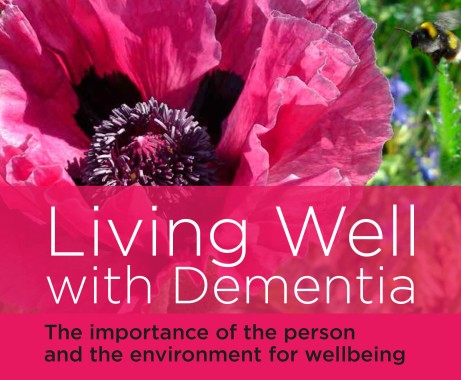Home » Posts tagged 'living better with dementia'
Tag Archives: living better with dementia
“Living better” with dementia is desirable, but what does it mean for care?
After having thought about it for more than one year, I’ve concluded that the term ‘living well with dementia’ is not the right one. For a start, it implies some objective, sometimes unattainable, standard. Also, I feel that some people are clearly not well with dementia with the dreadful state of post-diagnostic care and support in some parts of the country, or personal symptoms which are difficult to manage (not living well with dementia from a lack of ability to communicate verbally, or intense ‘night terrors’). Each person living with dementia is more than the dementia, and I am mindful of not projecting an over sanitised portrayal of the dementias.
Somebody I truly admire in her work and general campaigning on dementia is Beth Britton. Beth has already made a huge impact in the co-production group at the CQC, and will, I am sure, make a massive impact on the Carers’ Commission. Having founded D4Dementia in May 2012, the blog was a finalist in the Roses Media Awards 2012 and has developed a huge following in the UK and internationally. The blog is genuinely loved and supported by thousands of families, carers, people with dementia, health and social care professionals, policy makers, leaders and anyone looking for a highly informative, personal and authoritative perspective on dementia.
I will publish my book ‘Living better with dementia: looking to the future’ later this year (around June – July 2015) with Jessica Kingsley Publishers. I feel that this book, although adopting both a domestic and international viewpoint, fits in very nicely with Beth’s corpus of impressively high quality work.
Chapter 1 provides an introduction to current policy in England, as it currently stands, including a review of the need for a ‘timely diagnosis’ as well as a right to timely post-diagnostic care. This has been a vocal concern of Baroness Sally Greengross, the current Chair of the All Party Parliamentary Group for dementia.
In England, the issue of the ‘timely diagnosis’ is an exquisitely sensitive one.
We’re lucky Beth, Ming Ho and Sal Marciano have contributed to this debate: viz:
Other carers, Beth Britton, Sally Ann Marciano and Ming Ho contributed their experience emphasising that support is essential and that good outcomes for the whole family, in addition to those of the person with dementia, should be taken into consideration.
This chapter also provides an overview of the current evidence base of the hugely popular “Dementia Friends” campaign run very successfully by the Alzheimer’s Society and Public Health England, to raise awareness about five key ‘facts’ about dementia. It was intended that this campaign should help to mitigate against stigma and discrimination that can be experienced by people living with dementia and their caregivers. The ‘proof of the pudding’ will come when the outcome of turning communication into action is assessed objectively.
Chapter 2 comprises a preliminary analysis of stigma, citizenship and the notion of ‘living better with dementia’. This chapter explains the urgency of the need to “frame the narrative” properly. This chapter also introduces the “Dementia Alliance International” group, which has fast become a highly influential campaigning force by people living with dementia for people living with dementia.
It is hoped that openness in discussion will help to mitigate against a deeply entrenched stigma by some.
Beth advises, in the Huffington Post, that:
As Margaret Thatcher joins the many people with dementia who have passed before her, and debates rage about her political legacy, I would argue that this is a time to talk as openly about her most recent experiences as it is to reflect on her career. An opportune moment for us all to think about what having dementia means, whether you are a former prime minister, a doctor, a professor, a grocer, a bus conductor or a refuse collector. Dementia brings a whole new meaning to being ‘all in this together’.
Chapter 3 looks at the various issues facing the timely diagnosis and post-diagnostic support of people living with dementia from diverse cultural backgrounds, including people from black, Asian and ethnic minority backgrounds, people who are lesbian, bisexual, gay or transsexual, and people with intellectual difficulties. Attention is paid to the various intricate ways in which exact culture can impact not only on the timely diagnosis of dementia but also in the post-diagnostic care.
Chapter 4 looks at the issue of how different jurisdictions around the world have formulated their national dementia strategies. Examples discussed of countries and continents are Africa, Australia, China, Europe, India, Japan, New Zealand, Puerto Rico and Scotland. There is remarkable convergence in the efforts of various jurisdictions, and it is here I first introduce the critical importance of collaboration. A major plus here has been the contribution of the Alzheimer’s Disease International in their work on the need for national dementia policies, and how to implement them.
Chapter 5 looks at the intense care vs care debate which has now surfaced in young onset dementia. There is a potentially problematic schism between resources being allocated into drugs for today and resources being used to fund adequately contemporary care to promote people living better with dementia. An example is discussed of how the policy of ‘Big Data’ had gathered momentum across a number of jurisdictions, offering personalised medicine as a further potential component of “person-centred care”.
This chapter also considers the impact of the diagnosis of younger onset dementia on the partner of the person with dementia as well. It can never be considered that a diagnosis is given in isolation:
As Beth remarks,
For us, devoid of any additional support or resources, we simply had to learn about dad’s dementia as it progressed, inevitably making mistakes along the way, but always trying our best to understand what his life was like and what he needed. Through the work I do now, I aim to use that knowledge to improve the lives of all those who are touched by dementia, increasing awareness and education in society as a whole, and transforming the care given to people with dementia and their families.
A candid description in my book was also given about the possible sequelae of the diagnosis of young onset dementia on employment, caregivers, and in social isolation.
Chapter 6 focuses on delirium, or the acute confusional state, and dementia. It attempts to explain why delirium and dementia might converge in policy, after all. There are general issues of whether it is possible to inject incentives into the system at critical points. However, in parallel with this, there is an active debate as to why delirium (however so labeled) is not picked up sometimes in hospital, why people who experience an episode of delirium can do quite badly in the long run, and what to do in the special case of a person living with dementia with delirium superimposed on that.
Chapter 7 is the largest chapter in this book, and takes as its theme care and support networks. I make no apologies about the length of this chapter, as I have been hugely influenced by the Dementia Action Alliance Carers Call to Action in the last year.
Beth comments that:
Most carers are totally unprepared for what caring will involve and have no idea when their caring role will end. They often ‘fall into’ caring, simply by taking on small responsibilities that escalate, triggering experiences that untrained family carers can find very difficult to cope with.
There is huge interest internationally in the subject of ‘what makes a good care home’, as Beth comments:
For me the gold-standards that every family should be looking for from a care home are person-centred care, compassion, dignity and respect. You want to know that your loved one will be treated as an individual in every possible aspect – not just another box to tick on a care plan. You also want to know that they will have access to anything and everything that constitutes therapeutic dementia care, and not just a range of set ‘activities’ that they have no interest in participating in.
The idea of families and professionals working side by side is a very powerful one.
Beth takes this idea up here:
This shows that when families and professionals work side-by-side it often creates a unique, and holistic, model of care. Relatives can also benefit from the support and knowledge that professionals caring for their loved one can provide in challenging times.
It should never be the case that those who have spent years being educated in their subject feel that their clinical training and evidence based approach carries greater weight, or that families adopt the viewpoint that their emotional ties and personal experience is all that is needed to effectively care for their loved one.
In my book, an overview of how patient-centred care is different from person-centred care is given, and how person-centred care differs from relationship-centred care. I feel, personally, that the literature has thus far excessively focused on the ‘dyadic relationship’ between the person with dementia and caregiver, but a need to enlarge this to a professional in a ‘triangle of care’ and extended social networks was further elaborated and emphasised.
Different care settings are described, including care homes, hospitals – including acute hospital care, and intermediate care. This chapter first introduces the critical role of clinical nursing specialists in dementia in providing proactive case management in a person-centred care philosophy.
However, Beth is right, in my opinion, to bring up the notion that “care homes are not police states“; rather care homes could be open to scrutiny whilst being part of an extended community.
Britton has her suspicions about the events that led to this crisis, but she is unable to prove them. Based on that experience, she supports the idea of CCTV in care home rooms on an opt-in basis: “A camera might not have saved his life, but it would have told us what happened. However, I don’t think they should be put everywhere for everyone. We don’t want to turn care homes into a police state.”
Chapter 8 considers eating for living well with dementia. This chapter considers enforceable standards in care homes, including protection against malnutrition or undernutrition. The main focus of the chapter is how people with dementia might present with alterations in their eating behaviour, and how the mealtime environment must be a vital consideration for living better with dementia. Eating well with dementia is clearly not all about finger snacks and the such like.
Chapter 9 looks at a particular co-morbidity, incontinence. Focusing on the various co-morbidities will be an opportunity of a whole person approach for a person living with dementia, during health as well as illness. The emphasis of this chapter is on conservative approaches for living well with dementia and incontinence. Other issues considered here are the impact of incontinence on personhood per se, and the possible impact on the move towards an institutional home.
Incontinence for a person living well with dementia is not all about pads. We have to, as a society, wish to talk about incontinence for people living with dementia, and I am hoping this chapter is a help.
I feel Beth has been instrumental – in her work – in breaking down societal taboos, for example:
How do you feel about the idea of needing someone to dress you, wash you, help you to the toilet or change your incontinence pads, feed you, give you medication, move you around, and enable you to watch the TV programmes of your choosing or listen to the music that you love?
This is day-to-day life for the many people who receive care. Such dependence can happen at any age, but it becomes more likely as you get older, making the need for care something people fear the most as they approach their mature years.
Chapter 10 argues how the needs for people living better with dementia would be best served by a fully integrated health and social care service in the form of “whole person care”. This chapter provided the rationale behind this policy instrument in England. This chapter argues how the needs for people living better with dementia would be best served by a fully integrated health and social care service. Currently too many NHS patients cannot be discharged out of social care in a timely fashion.
We certainly do need to be looking forward to the future now.
As Beth says,
In 15 years’ time we must have a health and social care system that is (finally) fully integrated. The UK should be leading the way in providing aged care, and recognising and fully supporting the role of family carers. More broadly, I want to be living in a society that makes ageing something we embrace and nurture, not something to be sneered at, marginalised and locked away.
Chapter 11 considers the importance of the social determinants of health. The framework, I argue, is eminently sensible for organising one’s thoughts about dementia friendly communities. The focus of this chapter is housing. I focused on design of buildings in my previous book ‘Living well with dementia’, but I wished to articulate here the wider context of the importance of housing for a person living well with dementia. Housing for living well with dementia is not just about buildings, and is pivotally enmeshed with the person centred care philosophy of projected English policy.
With such a broad brush tool as equality and “dementia friendly communities”, the scope for squashing diversity is enormous. Few topics enter the realms of “one glove does not fit all” to the same degree as the potential use of global positioning systems for dementia. Chapter 12 considers whether ‘wandering’ is the most appropriate term. The main emphasis of this chapter is the legal and ethical considerations in the use of ‘global positioning systems’ in enhancing the quality of life of persons with dementia and their closest ones. A central theme of this chapter is what might be best for the piece of mind of the person in a caring role might not be entirely synchronous as the wishes of the person himself or herself with dementia. To show how extreme the term “wandering” potentially becomes, I am aware of some friends of mine living with dementia who simply wish to go for a pleasant walk, but are frightened of being labeled as “wanderers”.
Chapter 13 considers head-on a number of important contemporary issues, with a main emphasis on human rights and “rights based approaches”. While there is no universal right to a budget, the implementation of personal budgets is discussed. This policy strand is indeed very complex. The chapter progresses to consider a number of legal issues which are arising, including genetic discrimination in the US jurisdiction, dementia as a disability under the equality legislation in England, and the importance of rights-based approaches for autonomy and dignity.
Nonetheless, “personalisation” remains a powerful strand in policy across many successive governments.
As Beth notes – in an apolitical way:
The first and most important thing to stress is that everyone is an individual, so what works for one person won’t work for another. True quality of life is only achieved through personalisation, therefore it is vital that everything you help someone with dementia to do, achieve or enjoy is what they have or would choose for themselves.
Too often the debate about dementia can be engulfed in a diatribe about ‘cost’ not ‘value’. Persons living better with dementia wish to contribute effectively with the outside world, and the feeling is mutual. Chapter 14 is primarily concerned with art and creativity, which can be incredibly empowering for some people trying to live better with dementia. This chapter takes as its focus on how living with dementia could lead to art and creativity. This chapter also looks at the exciting developments in our understanding of the perception of music in people living with dementia, and why music has the potential to enhance the quality of life for a person living well with dementia through its intrinsic features as a reward.
Too often the focus in international policies is on medications.
I believe the interest in ‘reminiscence’ is very well deserved.
Beth describes it thus:
Dad’s room was filled with pictures, cushions depicting farmyard scenes and life-like soft toy animals – everything chosen because it told some part of his story. At the heart of that was dad’s memory box displaying captioned photographs charting dad’s life from his birth to mine, alongside emblems that represented his home county and favourite football team.
All of these reminiscence therapies combined to keep dad’s identity alive, much in the same way that resources like Memory Bank can do for people who are living with dementia today. These aids help to focus on the uniqueness of the individual, and provide focal points for conversation that ensure each person’s story is brought to life.
Chapter 15 looked at the triggering of football sporting memories in people living well with dementia. This chapter considers the cognitive neuroscience of the phenomenon of this triggering, and presents a synthesis of how the phenomenon could be best explained through understanding the role of emotional memory in memory retrieval, how autobiographical memories are represented in the human brain usually, the special relevance of faces or even smells such as “Bovril”. The triggering of football memories may have some neuroscientific commonalities with the triggering of musical memories, and it will be interesting in the future to identify carefully which people living better with dementia benefit from such reminiscence approaches.
Chapter 16 looks at the impact of various innovations in English dementia policy, giving as examples including service provision (such as the policy on reducing inappropriate use of antipsychotics or the policy in timely diagnosis) and research. This policy goes through the current evidence for this evidence in particular detail, and considers how culture change may be effected internationally for quality in this policy area. This chapter tries to convey the complexity of the issue, and to explain in a fair way why deep down in this policy plank are traditional concerns to do with ‘continuity of care’ and ‘valid consent’.
Chapter 17 looks at how leadership could be promoted by people living with dementia themselves. I first introduce the need for this in Chapter 2. Chapter 17 considers who might lead the change, where and when, and why this change might be necessary to ‘recalibrate’ the current global debate about dementia. This chapter considers how change might be brought about from the edge, how silos might be avoided, the issue of ‘tempered radicals’ in the context of transformative change to wellbeing as an outcome; and finally how ‘Dementia Champions’ are vital for this change to be effected.
Finally, I attempt a Conclusion at Chapter 18.
Living better with dementia: a “Year of Care” for dementia?
This is an extract from my book ‘Living better with dementia’ by me (Forewords by Prof Alistair Burns, Kate Swaffer, Chris Mason and Dr Peter Gordon), to be published by Jessica Kinglsey Publishers 2015. It comes from the chapter on whole person care (chapter 10).
Acute medicine is ideally suited to the medical model where you make a diagnosis on the basis of investigations, and then you immediately implement a management plan. There should of course be prompt action on acute situations for people living with dementia, but this is rather different to the usual needs of a person trying to live better with dementia. A person with a long term condition “lives with the condition day by day for their whole life and it is the things they do or don’t do that will make the difference to their quality of life and the long term outcomes they will experience” (Royal College of General Practitioners, 2011).
Shirley Ayres (2014) argues in her article entitled “The long term care revolution: a provocation paper” that “people in later life offer wisdom, experience, perspective and a wide range of skill sets and capacities”, reflecting that that long term institutional care is not the correct setting for them. This argument also holds true, perhaps, for people living well with advanced dementia.
The burning question still remains, as it was in the genesis of the first English dementia strategy, how a framework of post-diagnostic support for people living with dementia could best take place in England. I have already discussed earlier in chapter 10 of my book the policy of ‘whole person care’, and the critical rôle of social care practitioners and clinical nursing specialists in a multidisciplinary approach. It is also worth noting that the “year of care” initiative has seen some crystallisation of the approach for living well. It offers a framework that supports delivery of the Domain 2 of the NHS Outcomes Framework ‘Enhancing quality of life for people with long-term conditions’. Through this, it is hoped that ‘far more people will have developed the knowledge, skills and confidence to manage their own health’, but there are clear implications for the implementation of whole person care, namely, “care which feels more joined-up to the users of services”, and “care [which] centres on the person as a whole, rather than on specific conditions” (Year of Care website, accessed December 2014).
There will always be the criticism that self management, rather than having the prime goal of encouraging health and wellbeing, is meant as a ‘cover’ for essential services being cut. Benefits of “self management” which have previously been proposed are, nonetheless, proposed in Box 1.
—————
Box 1. Benefits of ‘self management’ [Source: Royal College of General Practitioners (Clinical Innovation and Research Centre) (2011) (authors: Nigel Mathers, Sue Roberts, Isabel Hodkinson and Brian Karet) Care Planning: Improving the Lives of People with Long Term Conditions]
When people self care and are supported to do this, they are more likely to:
- experience better health and well-being
- reduce the perceived severity of their symptoms, including pain
- improve medicines compliance
- prevent the need for emergency health and social services
- prevent unnecessary hospital admissions
- have better planned and co-ordinated care
- remain in their own home
- have greater confidence and a sense of control
- have better mental health and less depression
—————
Indeed, this policy agenda has been slowly ‘cooking’ for about year. For example, nearly a decade ago, Department of Health (2005) issued its document “Supporting People and integration with Long Term Conditions – An NHS and Social Care Model to support local innovation: Improving Care Improving Lives” had proposed a number of key priority areas, namely:
- To embed into local health and social care communities an effective, systematic approach to the care and management of patients with a long term condition.
- To reduce the reliance on secondary care services and increase the provision of care in a primary, community or home environment.
- Patients with long term conditions need high-quality care personalised to meet their individual requirements.
This follows on from an elegant analysis from one of Derek Wanless’ numerous reports, this time “Securing our Future Health: Taking a Long-Term View” from 2002. This one envisages one scenario for the future involving full public engagement.
Wanless (2002) describes this as,
“levels of public engagement in relation to their health are high. Life expectancy increases go beyond current forecasts, health status improves dramatically and people are confident in the health system and demand high quality care. The health service is responsive with high rates of technology uptake, particularly in relation to disease prevention. Use of resources is more efficient.”
(Derek Wanless, Public Enquiry Unit (2002))
It has become increasingly acknowledged that under this approach, the “care plan” is pivotal. The care plan “should set out the patient’s agreed health objectives and care needs, including what the individual can contribute towards their own self care, and what each professional and agency will do to help them meet these. It will include preventive and health promotion actions (such as avoiding accidents, reducing infection or nutrition).” (Department of Health, 2005).
In a pamphlet from the King’s Fund (2013), entitled “Delivering better services for people with long-term conditions”, the authors, Angela Coulter, Sue Roberts and Anna Dixon describe a co-ordinated service delivery model – the ‘house of care’ – that incorporates learning from a number of sites in England that have been working to achieve these goals.
They describe that the “house of care” model differs from others in two important ways:
- it encompasses all people with long-term conditions, not just those with a single disease or in high-risk groups;
- and it assumes an active role for patients, with collaborative personalised care planning at its heart.
This model is a system innovation, as applied to dementia, as it proposes a shift in power from professionals to persons living with dementia play an active part in determining their own care and support needs. Such an approach, it is hoped, would respect autonomy dignity, promote independence and offer maximum choice and control for need help from the health and care systems. The philosophy of “whole person care” moves the NHS towards an integrated health and care system, which is concerned about individuals during health as well as disease, a critical time when the coordination between the NHS and social care could not possibly be worse.
Self care is about individuals, families and communities taking responsibility for their own health and wellbeing. It includes actions people take in order to stay fit and maintain good physical and mental health, meet their social and psychological needs, prevent illness or accidents and care more effectively for minor ailments and long term conditions.
Both dementia and diabetes mellitus can be viewed as disabilities, and each may be a co-morbidity of the other. Sinclair and colleagues (2014) have outlined the key steps in an integrated care pathway for both elements of this clinical relationship, produced guidance on identifying each condition, dealt with the potentially risky issue of hypoglycaemia, and have outlined important competencies required of healthcare workers in both medical/diabetes and mental health settings to enhance clinical care. In the overall construct, people living with a long term condition, disability or a minor illness, as well as carers, can benefit enormously from being supported to self care.
The ‘Common Core Principles to Support Self Care’ aim to help health and social care services give people control over, and responsibility for, their own health and well-being, working in partnership with health and social care professionals (Skills for Care/Skills for Health, 2007) Seven principles have been elaborated. These are shown in Box 2 below.
—————
Box 2. Seven principles to support ‘self care’ [Source: Skills for Care/Skills for Health (2007)“Common core principles to support self care: a guide to support implementation” http://www.skillsforcare.org.uk/document-library/skills/self-care/commoncoreprinciples.pdf]
- Ensure individuals are able to make informed choices to manage their self care needs
- Communicate effectively to enable individuals to assess their needs, and develop and gain confidence to self care
- Support and enable individuals to access appropriate information to manage their self care needs
- Support and enable individuals to develop skills in self care
- Support and enable individuals to use technology to support self care
- Advise individuals how to access support networks and participate in the planning, development and evaluation of services
- Support and enable risk management and risk taking to maximise independence and choice.
—————
The “NICE quality standard for supporting people to live well with dementia: information for the public” is intended to support people to live well with dementia. It sets out how high-quality social care services should be organised and what high-quality social care should include, so that the best support can be offered to people with dementia using social care services in England (NICE, 2013). This has provided a very useful yardstick against which services which purport to improve the quality of life of people with dementia can be judged.
It is, further, reported that the ‘Year of Care’ (YOC) programme was successful in implementing the key features of care planning in diabetes, for example. The YOC Programme has two components, according to ‘Diabetes UK’ (2011). Firstly, it enhances the routine biomedical surveillance and ‘QOF review’ with a collaborative consultation, based on shared decision making and self management support, via care planning; and then it ensures there is a choice of local services people need to support the actions they want to take to improve their health, wellbeing and health outcomes.
People are involved in the care of their diabetes in quite a new way and enjoying it. People are setting personal goals and action plans relevant to their everyday life; take up of education programmes has improved and in very disadvantaged populations, poor attendance rates, biomedical outcomes and service use are also improving.
(Royal College of General Practitioners, 2011)
It is likely that the health and care sectors will seek to engineer the ‘best’ solutions on offer for post diagnostic support, within a framework of ‘whole person care’.
Such solutions might include ‘dementia advisers’, ‘clinical nursing specialists’, or ‘a year of care’. The solutions most appropriate for “living better with dementia” might be drawn, for example, from best practice in other long term conditions, such as diabetes or cancer. The quality of local commissioning, undoubtedly, is going to be pivotal in this. It will be a sensitive policy balance to make the argument that responsibilities of the State are not shunted across to the third sector in an unaccountable or unorthodox manner. But many will argue that there is valid and crucial role for the third sector to play. Actually, the policy imperative for this could not be clearer – many persons living well with dementia report not expecting to see a professional until the end of life phase, having seen one for the initial diagnosis. This is clearly not on if policy truly wishes to promote living better with dementia in England.
References
Department of Health (2005) “Supporting People and integration with Long Term Conditions – An NHS and Social Care Model to support local innovation: Improving Care Improving Lives”, accessed 6 December 2014,available at: http://webarchive.nationalarchives.gov.uk/+/www.dh.gov.uk/en/Publicationsandstatistics/Publications/PublicationsPolicyAndGuidance/Browsable/DH_4965951
Diabetes (UK) “Year of Care: Report of findings from the pilot programme” (date June 2011), accessed 6 December 2014,available at: http://www.diabetes.org.uk/upload/Professionals/Year%20of%20Care/YOC_Report.pdf
Innovate UK (2014) The long term care revolution: a provocation paper. (author Shirley Ayres), accessed 6 December 2014,available at: https://connect.innovateuk.org/documents/15494238/0/LTCRprovocationPaper.pdf/45cf1947-c477-4f21-913e-4eb3f9061aa0
King’s Fund (2013) (authors: Angela Coulter, Sue Roberts and Anna Dixon, October 13) “Delivering better services for people with long-term conditions”, accessed 6 December 2014,available at: http://www.kingsfund.org.uk/sites/files/kf/field/field_publication_file/delivering-better-services-for-people-with-long-term-conditions.pdf
NICE quality standard 30 April 2013 NICE quality standard for supporting people to live well with dementia: information for the public, accessed 6 December 2014,available at: https://www.nice.org.uk/guidance/qs30
“Policy: A Year of Care”, accessed 6 December 2014,available at: http://www.yearofcare.co.uk/policy-0
Public Enquiry Unit (2002) “Securing our Future Health: Taking a Long-Term View. Final Report” (author Derek Wanless), accessed 6 December 2014, available at: http://si.easp.es/derechosciudadania/wp-content/uploads/2009/10/4.Informe-Wanless.pdf
Royal College of General Practitioners (Clinical Innovation and Research Centre) (2011) (authors: Nigel Mathers, Sue Roberts, Isabel Hodkinson and Brian Karet) Care Planning: Improving the Lives of People with Long Term Conditions, accessed 6 December 2014, available at: http://www.impressresp.com/index.php?option=com_docman&task=doc_view&gid=75&Itemid=70
Sinclair AJ, Hillson R, Bayer AJ; National Expert Working Group. Diabetes and dementia in older people: a Best Clinical Practice Statement by a multidisciplinary National Expert Working Group. Diabet Med. 2014 Sep;31(9):1024-31. doi: 10.1111/dme.12467.
Skills for Care/Skills for Health (2007) “Common core principles to support self care: a guide to support implementation”, accessed 6 December 2014,available at: http://www.skillsforcare.org.uk/document-library/skills/self-care/commoncoreprinciples.pdf
The final conclusion to my book on living better with dementia
Anything can happen to anyone at any time. Despite all the best initiatives in the world, it will be unachievable to extinguish all negative perceptions about dementia. Nobody can deny the imperative for communities and society to be inclusive and accessible for people with dementia, but is no mean feat to rationalise with more individualistic approaches ranging from personal budgets, human rights and equality law responsibilities. It really is not a question of what a person can no longer do. It is an issue of what a person can currently do, and this might include, for example, unleashing of previously unwitnessed artistic and creative talents.
All jurisdictions converge on the right for a timely diagnosis and a right to timely post-diagnostic support, but political grandstanding over cures will be small change to those people currently wanting to live better with dementia. People who have received a diagnosis of dementia are not all consumers, and some do not even interact with health and care services as patients. They are all persons, however, and wish for inalienable dignity and respect. Everyone knows that the diagnosis affects not just the person with dementia,but their whole network of friends and family. There now must be a political will to do something about this, and this is not just a societal issue for the G7. Silos must be abolished; for example, in considering eating better with dementia, the emphasis can no longer be on the design of ‘finger snacks’, but responsible thought has to be put into how certain mealtime environments work (or do not work). It is utterly pointless talking about joining initiatives to encourage ‘dementia friendliness’, while words such as ‘victim’ continue to litter the mainstream press. And “leading” scientists and practitioners can unwittingly perpetuate stigma through somewhat perjorative language such as ‘wanderer’; the willful blindness to this must stop too. Living better with dementia is not just an aspiration; it is in many places legally enforceable.
Bring it on.
An overview of my book ‘Living better with dementia: champions for enhanced communities”.
I hope you find this overview of my book ‘Living better with dementia: champions for enhanced communities’ useful.
It is written by me.
And the Forewords are Prof Alistair Burns, the England clinical lead for dementia, Kate Swaffer (Alzheimer’s Australia, Dementia Alliance International, and University of Wollongong, Australia), Chris Roberts (Dementia Action Alliance Carers Call to Action, Dementia Alliance International), and Dr Peter Gordon (Consultant Psychiatrist in dementia and cognitive disorders, NHS Scotland).
It will primarily assess where we’ve got to, along with other countries, in improving diagnosis and post-diagnostic care, and assess realistically the work still yet to be done.
My thesis will articulate why the ‘reboot’ of the global “dementia friendly communities” must now take account of various issues to be meaningful. It will argue for a difference in emphasis from competitive ‘nudge’ towards universal legal and enforceable human rights promoting dignity and autonomy.
It will also argue that dementia friendly communities are meaningless unless there is a shift in the use of language away from ‘sufferers’ and ‘victims’, while paying tribute to the successful “Dementia Friends” initiative.
It will, further, argue that dementia friendly communities are best served by a large scale service transformation to ‘whole person care’, and provide the rationale for this. A critical factor for enhancing the quality of life of people living better with dementia will be to tackle meaningfully the social determinants of health, such as housing and education.
The thesis will also argue that dementia friendly communities must also value the behaviours, skills and knowledge of caregivers in wider support networks. This is essential for the development of a proactive service, with clinical specialist nursing input deservedly valued, especially given the enormous co-morbidity of dementia.
This title will be published by Jessica Kingsley Publishers, in early 2015.
Chapters overview
Chapter 1 provided an introduction to current policy in England, including a review of the need for a ‘timely diagnosis’ as well as a right to timely post-diagnostic care. This chapter also provided an overview of the current evidence base of the hugely popular “Dementia Friends” campaign run by the Alzheimer’s Society and Public Health England, to raise awareness about five key ‘facts’ about dementia. It was intended that this campaign should help to mitigate against stigma and discrimination that can be experienced by people living with dementia and their caregivers.
Chapter 2 comprised a preliminary analysis of stigma, citizenship and the notion of ‘living better with dementia’. This chapter explained the urgency of the need to “frame the narrative” properly. This chapter also introduced the “Dementia Alliance International” which has fast become a highly influential campaigning force by people living with dementia for people living with dementia.
Chapter 3 looked at the various issues facing the timely diagnosis and post-diagnostic support of people living with dementia from diverse cultural backgrounds, including people from black, Asian and ethnic minority backgrounds, people who are lesbian, bisexual, gay or transsexual, and people with prior learning difficulties.
Chapter 4 looked at the issue of how different jurisdictions around the world have formulated their national dementia strategies. Examples discussed of countries and continents were Africa, Australia, China, Europe, India, Japan, New Zealand, Puerto Rico and Scotland.
Chapter 5 looked at the intense care vs care debate which has now surfaced in young onset dementia, with a potentially problematic schism between resources being allocated into drugs for today and resources being used to fund adequately contemporary care to promote people living better with dementia. An example was discussed of how the policy of ‘Big Data’ had gathered momentum across a number of jurisdictions, offering personalised medicine as a further potential compontent of person-centred care. This chapter also considered the impact of the diagnosis of younger onset dementia on the partner of the person with dementia as well. A candid description was also given about the possible sequelae of the diagnosis of young onset dementia on employment, caregivers, and in social isolation.
Chapter 6 focused on delirium, or the acute confusional state, and dementia. It considered the NICE guidelines for delirium, and the pitfalls in considering the relationship between delirium and dementia in English policy.
Chapter 7 was the largest chapter in this book, and took as its theme care and support networks. An overview of how patient-centred care is different from person-centred care was given, and how person-centred care differs from relationship-centred care. The literature inevitably has thus far focused on the ‘dyadic relationship’ between the person with dementia and caregiver, but a need to enlarge this to a professional in a ‘triangle of care’ and extended social networks was further elaborated and emphasised. Finally, the importance of clinical specialist nurses in ‘dementia friendly communities’ was argued, as well as the Dementia Action Alliance’s “Carers Call to Action”. Different care settings were described, including care homes, hospitals – including acute hospital care, and intermediate care.
Chapter 8 considered eating for living well with dementia. This chapter considered enforceable standards in care homes, including protection against malnutrition or undernutrition. The main focus of the chapter was how people with dementia might present with alternations in their eating behaviour, and how the mealtime environment must be a vital consideration for living better with dementia.
Chapter 9 looked at a particular comorbidity, incontinence. The emphasis was on conservative approaches for living well with dementia and incontinence. Other issues considered were the impact of incontinence on personhood per se, and the possible impact on the move towards an institutional home.
Chapter 10 argued how the needs for people living better with dementia would be best served by a fully integrated health and social care service. This chapter provided the rationale behind this policy instrument in England. The chapter also considered various aspects of what would be likely to make ‘whole person care’ work, including data sharing, collaborative leadership, care-coordinators, responsible and accountable ‘self care’, and the multi-disciplinary team. This chapter also considered how it was impossible to divorce physical health from mental health and social care, and explained the intention of the longstanding drive towards ‘parity of esteem’ in English policy.
Chapter 11 considered the importance of the social determinants of health. A focus of this chapter was on education, and its impact on a person living with dementia. However, the main focus of this chapter was housing, including ‘dementia friendliness, downsizing, and green or public spaces.
Chapter 12 considered whether ‘wandering’ is the most appropriate term. The main emphasis of this chapter were the legal and ethical considerations in the use of ‘global positioning systems’ in enhancing the quality of life of persons with dementia and their closest ones.
Chapter 13 considered a number of important contemporary issues, with a main emphasis on human rights and “rights based approaches”. While there is no universal right to a budget, the implementation of personal budgets was discussed. The chapter progressed to consider a number of legal issues which are arising, including genetic discrimination in the US jurisdiction, dementia as a disability under the equality legislation in England, and the importance of rights-based approaches for autonomy and dignity. Finally, the issue of engagement was considered.
Chapter 14 was primarily concerned with art and creativity. This chapter took as its focus on how living with dementia could lead to art and creativity, and how the cultural needs of people living with dementia could best be furnished through laughter, poetry and art galleries or museums. This focus also looked at the exciting developments in our understanding of the perception of music in people living with dementia, and how music has the potential to enhance the quality of life for a person living well with dementia.
Chapter 15 looked at the triggering of football sporting memories in people living well with dementia. This chapter considered the cognitive neuroscience of the phenomenon of this triggering, and presented a synthesis of how the phenomenon could be best explained through understanding the role of emotional memory in memory retrieval, how autobiographical memories are represented in the human brain usually, the special relevance of faces or even smells such as “Bovril”.
Chapter 16 looked at the impact of various innovations in English dementia policy, giving as examples including service provision (such as the policy on reducing inappropriate use of antipsychotics or the policy in timely diagnosis) and research. This chapter also contemplated the principal factors affecting how innovations can become known, and what ultimately determines their success.
Chapter 17 looked at how leadership could be promoted by people living with dementia. This chapter considered who might lead the change, where and when, and why this change might be necessary to ‘recalibrate’ the current global debate about dementia. This chapter considered how change might be brought about from the edge, how silos might be avoided, the issue of ‘tempered radicals’ in the context of transformative change to wellbeing as an outcome; and finally how ‘Dementia Champions’ are vital for this change to be effected.
Please note that Beth is not endorsing this book – this image is entirely separate and is taken from the main event for G8 dementia – we’re all proud of Beth’s work meanwhile!
Culture and diversity in living well with dementia
This is a very important chapter to me.
Culture and diversity considerations are hugely pervasive in all of English dementia policy: from the point of timely diagnosis and throughout the course of post diagnostic support.
These are the academic journal references I wish to include in my chapter for my book ‘Living better with dementia: champions for enhanced friendly communities”.
Please do let me know of any initiatives, projects, published papers or reports that you should like me to include in this chapter.
What is listed below is only a start. It does include blogposts, which I intend to include too.
This chapter is of course hugely relevant to global dementia policy.
Aminzadeh F, Byszewski A, Molnar FJ, Eisner M. Emotional impact of dementia diagnosis: exploring persons with dementia and caregivers’ perspectives. Aging Ment Health. 2007 May;11(3):281-90.
Botsford J, Clarke CL, Gibb CE. Dementia and relationships: experiences of partners in minority ethnic communities. J Adv Nurs. 2012 Oct;68(10):2207-17. doi: 10.1111/j.1365 2648.2011.05905.x. Epub 2011 Dec 11.
Bowes A, Wilkinson H. ‘We didn’t know it would get that bad': South Asian experiences of dementia and the service response. Health Soc Care Community. 2003 Sep;11(5):387-96.
Burns A, Mittelman M, Cole C, Morris J, Winter J, Page S, Brodaty H. Transcultural influences in dementia care: observations from a psychosocial intervention study. Dement Geriatr Cogn Disord. 2010;30(5):417-23. doi: 10.1159/000314860. Epub 2010 Nov 12.
Chan WC, Ng C, Mok CC, Wong FL, Pang SL, Chiu HF. Lived experience of caregivers of persons with dementia in Hong Kong: a qualitative study. East Asian Arch Psychiatry. 2010 Dec;20(4):163-8.
Connell CM, Gibson GD. Racial, ethnic, and cultural differences in dementia caregiving: review and analysis. Gerontologist. 1997 Jun;37(3):355-64.
Day A, Francisco A. Social and emotional wellbeing in Indigenous Australians: identifying promising interventions. Aust N Z J Public Health. 2013 Aug;37(4):350-5. doi: 10.1111/1753 6405.12083.
Friedman MR, Stall R, Silvestre AJ, Mustanski B, Shoptaw S, Surkan PJ, Rinaldo CR, Plankey MW. Stuck in the middle: longitudinal HIV-related health disparities among men who have sex with men and women. J Acquire Immune Defic Syndr. 2014 Jun 1;66(2):213-20. doi: 10.1097/QAI.0000000000000143.
Johl N, Patterson T, Pearson L. What do we know about the attitudes, experiences and needs of Black and minority ethnic carers of people with dementia in the United Kingdom? A systematic review of empirical research findings. Dementia (London). 2014 May 22. pii: 1471301214534424. [Epub ahead of print]
Khan F, Tadros G. Complexity in cognitive assessment of elderly British minority ethnic groups: Cultural perspective. Dementia (London). 2013 Feb 21;13(4):467-482. [Epub ahead of print]
Kirk LJ Hick R, Laraway A. Assessing dementia in people with learning disabilities: the relationship between two screening measures. J Intellect Disabil. 2006 Dec;10(4):357-64.
La Fontaine J, Ahuja J, Bradbury NM, Phillips S, Oyebode JR. Understanding dementia amongst people in minority ethnic and cultural groups. J Adv Nurs. 2007 Dec;60(6):605-14.
Lim YY, Pietrzak RH, Snyder PJ, Darby D, Maruff P. Preliminary data on the effect of culture on the assessment of Alzheimer’s disease-related verbal memory impairment with the International Shopping List Test. Arch Clin Neuropsychol. 2012 Mar;27(2):136-47. doi: 10.1093/arclin/acr102. Epub 2011 Dec 23.
Llewellyn, P. The needs of people with learning disabilities who develop dementia: A literature review. Dementia 2011 10: 235-247.
Low LF, Anstey KJ, Lackersteen SM, Camit M, Harrison F, Draper B, Brodaty H. Recognition, attitudes and causal beliefs regarding dementia in Italian, Greek and Chinese Australians. Dement Geriatr Cogn Disord. 2010;30(6):499-508. doi: 10.1159/000321667. Epub 2011 Jan 20.
Manthorpe J, Moriarty J. Examining day centre provision for older people in the UK using the Equality Act 2010: findings of a scoping review. Health Soc Care Community. 2014 Jul;22(4):352-60. doi: 10.1111/hsc.12065. Epub 2013 Aug 17.
McCleary L, Persaud M, Hum S, Pimlott NJ, Cohen CA, Koehn S, Leung KK, Dalziel WB, Kozak J, Emerson VF, Silvius JL, Garcia L, Drummond N. Pathways to dementia diagnosis among South Asian Canadians. Dementia (London). 2013 Nov;12(6):769-89. doi: 10.1177/1471301212444806. Epub 2012 Apr 26.
Morhardt D, Pereyra M, Iris M. Seeking a diagnosis for memory problems: the experiences of caregivers and families in 5 limited English proficiency communities. Alzheimer Dis Assoc Disord. 2010 Jul-Sep;24 Suppl:S42-8. doi: 10.1097/WAD.0b013e3181f14ad5.
Nakanishi M, Nakashima T. Features of the Japanese national dementia strategy in comparison with international dementia policies: How should a national dementia policy interact with the public health- and social-care systems? Alzheimers Dement. 2014 Jul;10(4):468-76.e3. doi: 10.1016/j.jalz.2013.06.005. Epub 2013 Aug 15.
Price E. Coming out to care: gay and lesbian carers’ experiences of dementia services. Health Soc Care Community. 2010 Mar;18(2):160-8. doi: 10.1111/j.1365-2524.2009.00884.x. Epub 2009 Aug 25.
Prince M, Acosta D, Chiu H, Scazufca M, Varghese M; 10/66 Dementia Research Group. Dementia diagnosis in developing countries: a cross-cultural validation study. Lancet. 2003 Mar 15;361(9361):909-17.
Regan JL. Ethnic minority, young onset, rare dementia type, depression: A case study of a Muslim male accessing UK dementia health and social care services. Dementia (London). 2014 May 22. pii: 1471301214534423. [Epub ahead of print]
Rovner BW Casten RJ, Harris LF. Cultural diversity and views on Alzheimer disease in older African Americans. Alzheimer Dis Assoc Disord. 2013 Apr-Jun;27(2):133-7. doi: 10.1097/WAD.0b013e3182654794.
Stokes LA, Combes H, Stokes G. Understanding the dementia diagnosis: the impact on the caregiving experience. Dementia (London). 2014 Jan;13(1):59-78. doi: 10.1177/1471301212447157. Epub 2012 Aug 3.
Sun F, Ong R, Burnette D. The influence of ethnicity and culture on dementia caregiving: a review of empirical studies on Chinese Americans. Am J Alzheimers Dis Other Demen. 2012 Feb;27(1):13-22. doi: 10.1177/1533317512438224.
Werner P, Karnieli-Miller O, Eidelman S. Current knowledge and future directions about the disclosure of dementia: a systematic review of the first decade of the 21st century. Alzheimers Dement. 2013 Mar;9(2):e74-88. doi: 10.1016/j.jalz.2012.02.006. Epub 2012 Oct 24.
Wilkinson, H, Kerr, D, Cunningham, C. Equipping staff to support people with an intellectual disability and dementia in care home settings Dementia vol 4(3) 387–400
The introduction to my chapter on leadership in my follow up book on wellbeing in dementia
“All Russia is our orchard. The earth is so wide, so beautiful, so full of wonderful places. [Pause]. Just think, Anya. Your grandfather, your great-grandfather and all your ancestors owned serfs, they owned human souls. Don’t you see that from every cherry-tree in the orchard, from every leaf and every trunk, men and women are gazing at you? if we’re to start living in the present isn’t it abundantly clear that we’ve first got to redeem our past and make a clean break with it? And we can only redeem it by suffering and getting down to real work for a change.”
Anton Chekhov, “The Cherry Orchard”
The #G7dementia leaders imposed some degree of finality by promising a dementia treatment or cure by 2025. But they are not real leaders in this context as there is no guarantee that they will physically there, in which case it will be impossible to attribute blame or success to them. And those did appear rather oblivious to much of the world around them. ‘Living well with dementia’ is exactly the sort of arena which will not benefit from a hierarchy of power, mandating people how to live well; a request not to think of elephants will quite often elicit the opposite result. For a start, most people do not wish to be micromanaged. It is clear nonetheless that members of the public will wish any correct diagnosis of dementia not to be unduly delayed, and to be given appropriate guidance about their condition. Such advice might vary from how to cope with depth perception difficulties, to how to deal with being unfairly dismissed in an employment context. These are valid considerations, and in a way analogous to ironing out inefficiencies; but that is where the comparison with a business ends. It is impossible to measure success in a dementia policy in terms of productivity.
Leaders in healthcare, including the dementias, will increasingly have to discuss matters with leaders in other disciplines. Whilst the followers might be diverse, it is clear that leaders will have diverse aims. Such aims might include promoting world-class research in publications and conferences, or might include world-class innovations for knowledge management in the service. Or leadership might involve, as a clinical leader on the ward, explaining to colleagues why there might more to a plan than medication. It is likely that more momentum for living well with dementia will come from people living with dementia, and caregivers, rather than Pharma or even large charities which focus on cure, care and prevention. Much of it does involve breaking down silos, but the converse of this is to build strong networks with a shared mission. The idea that a person with dementia can be at ease with himself or herself and his environment is a very powerful one, and not easily achieved by consideration of manipulations of single receptors in the central nervous system. The case for improving the quality of life of people should be coherently communicated, and not get sidetracked by what costs more; it turns out that technology is more of a burden on the NHS budget than the ageing population in any case. The trick is of course not to throw the baby out with the bathwater in any change of approach, and, as a leader, to keep composed even if the world dynamics in dementia policy appear very turbulent.
A com
“Leadership is the art of mobilizing others to want to struggle for shared aspirations.”
“McLaughlin: Leadership has so many definitions that sometimes that term loses its meaning. How do you define it?
Kouzes: Leadership is the art of mobilizing others to want to struggle for shared aspirations. That part about struggling for shared aspirations may set our definition apart.”
I’ve also been though the motions of detailed study of leadership styles in my own MBA.
But this definition of James Kouzes really struck a chord with me.
This is of course not a particularly impressive ‘leadership style’, one sedentary guy with an iPad mini with a large product placement in shot?
I have fleetingly thought too about who is the exact target audience of my book.
While ‘Living well with dementia’ is not a ‘self help book’, it is a fact that many people living well with dementia have warmly received the book.
In fact, in the front row in my line of vision to the left, two people sat, a son and his mother with dementia.
It turns out the son found my talk ‘inspiring’, and thanked me, in front of his mother, for saying which he perceived as powerful: that it’s more important to concentrate on what people can do in the present, rather than they cannot do.
And what did I conclude was the driving intention of an international policy plank about living well with dementia?
I concluded that a positive wellbeing is about a person being content with himself or herself, and his or her own environment.
This is not an issue of being drugged up with a ‘cure for dementia’. It is though saying something equally positive about dementia, if not more positive.
I do not consider the Alzheimer’s Show an “event with a buzz”. For me, it was like a wedding of a best friend. I was thrilled to meet Chris, Jayne, Suzy, Rachel, Louise, Natasha, Joyce, Nigel, Tracey, Tony, and Tommy, some for the first time.
And what you see is what you get with them.
Chris concluded, “Living better with dementia would’ve been a better title.”
And Tommy agreed.
Chris and Tommy live well with dementia.
I agreed too. In a nutshell, ‘living well with dementia’ runs the danger of imposing your moral judgment or ‘standards’ on what living well with dementia is.
For me, living well in alcoholic recovery means not downing a bottle of neat gin when I get up, like I used to do in late 2006/early 2007 when I hit a rock bottom. (The actual rock bottom was when I had a cardiac arrest and epileptic seizure heralding a six week coma in the summer of 2007, rendering me physically disabled.)
But it’s a big thing for me that people who are living well with dementia are actually interested in – and supportive of – my book.
You see, I concede that I don’t live with a dementia yet to my knowledge – though many London cabbies conclude that I do [nicely], when I tell them the title of my book and they see me struggling get into their cab.
Chris pointed out something at first glance very true today – that I didn’t have many friends living with dementia as friends then, when I was writing my book.
Chris is in fact wrong. “Any” not “many”.
Tommy said something curious recently, that it’s ironic that it took an event such as the Alzheimer’s Show in Manchester to bring us all together.
But he’s right. We’re not there for any other reason than to share experiences.
Suzy commented that ‘I get it’. And I do think do, for all sorts of reasons, many of which were quite unintended.
I am currently writing ‘Living better with dementia: champions challenging the boundaries”. It’s going to be a toughie, but I think I can do it.
If only Kate were there too…
Why I am extremely grateful to key individuals for thoughts on my new book
I have spent ages thinking about the contents of my new book on living well with dementia. I submit the manuscript at the end of October 2014, so I have a bit of time yet.
I think the easiest part is the published literature base on which to draw the narrative from. This gives an useful indication about the direction of travel of approaches to dementia.
It’s ‘awkward’ singling people out, but on this occasion, if I may, I would like to.
Jo Moriarty (@aspirantdiva) is at the Social Care Workforce Research Unit at King’s College London.
“Jo joined the Unit in 2002 following the transfer of the National Institute for Social Work Research Unit to King’s College London. Research interests include social work education and dementia care training for social care professionals. … Jo is the Editor of the Innovative Practice Section Dementia: the International Journal of Social Research and Practice.”
Kate Swaffer (@KateSwaffer) is a close friend of mine, and we share between us many concerns in common. I don’t think Kate needs any introduction. Kate has educated me on various initiatives working globally, especially in Australia; but the odd combination of warmth and grittiness of the Dementia Alliance International, a group of people living with different causes of dementia, continues to inspire me.
Chris Roberts (@mason4233) is also a very good friend of mine. Although I’ve never met Chris, we’re hoping to do a @DementiaFriends session at BPP Law School on 1 December 2014.
Norman McNamara (@norrms) doesn’t know he has influenced my book, but the chapter synthesising the competing needs of persons with dementia, their friends and family and others in the use of GPS trackers as smart technology involves a balanced proportionate response on the basis of human rights, as well as an understanding of the cognitive neurology of why people with dementia might want to walk out of their local environment.
Tony Jameson Allen (@TJA_evonet) is somebody who shares EXACTLY my sense of humour. I once had a nice pizza with Tony off Oxford Street, and I explained there my wish to give a coherent explanation of the basis of ‘sporting memories’ based on current neuroscience. I intend to weave in an explanation of musical playlists for reminiscence too here.
I would not of course be so grandiose as to call my friends here a ‘steering group’, but a number of principles have come to light.
I now do not feel it would be useful to anchor the book in a single policy document, however currently influential, as it is indeed true policy documents come and go. They are often highly biased to the interests of their authors or their ‘paymasters’.
I cannot promote global policy if emanating from a single charity. This really does run the risk of promoting charities at the expense of promoting awareness of issues to do with living well with dementia, although often the two may collide.
There are huge problems with firmly entrenching the book in England only. The narrative is hugely relevant to Scotland, Northern Ireland, and Wales, as well as Australia and Argentina, where indeed the audience may even in fact be more sympathetic.
I do not feel that my book on dementia should be intended as a ‘bible’ of policy written for policy wonks. The people I have always been most interested in influencing are people with dementia, people in the care and support network, students (who include future leaders of tomorrow both within and external to the workforce), and practitioners.
I have, paradoxically, no interest in influencing academics, in that I really share the pain of academics needing to advance their own research grants and their own agendas. One of the best things about not being paid to do my research is that I can look unemotionally at the issues.
The other ‘issue’ is that I do not wish to articulate a vision too far forward in the future. Jo pointed me in the direction of a THES fantastic article on writing a textbook. Otherwise, the book ends up being too speculative and quite unhelpful for people currently at the coalface.
I have had it up to my neck in people ‘seeking opportunities’ in dementia. I of course do not wish to be hypocritical.
At quite large cost to myself, in the sense I am paying for my own flight, accommodation and conference pass, I have agreed to do a book signing session for ‘Living well with dementia’ at the @AlzAssociation conference in Copenhagen later this month. The details are here.
I will also likewise on my own present my non-clinical research on policy at the @AlzheimerEurope conference in Glasgow later this year. The details are here.
But I wish people ‘seeking opportunities’ well. I understand their pressures as small enterprises. But I have an agenda of my own – to share with the outside world the various ins- and outs- of how a person living well with dementia can interact positively with his or her own environment. This is not the same as promoting ‘person-centred care’, currently in vogue. And this is certainly not the same as promoting ‘purse-centred care’ as my friend Kate calls it (#KoalaHugs).
Political parties come and go. The greatest challenge I feel for persons living with dementia, their friends and families comes from the politicians mucking things up for them.
I think fixating on a cure serves to promote a narrow set of interests.
Bear in mind I’ve been in this field on-and-off for the last seventeen years.
Don’t promote your agendas in my name, please.
Updated plan for my new #dementia book – comments very welcome
The aim of this book is two fold
1. First to hoover up topics I didn’t properly address the first time around in my book ‘Living well with dementia‘.
2. To try to cover the more common themes in various guises of ‘Dementia Champions’ courses held in England.
I would be extremely grateful for any topics in the list you’d like me to focus on.
Updated plans for a book ‘Living better with dementia’
I personally think I’ve made a good start in describing the rationale in the English policy for ‘Living well with dementia‘.
On the other hand, from talking with various people in person, and from conversations I’ve had in the social media, I feel there are some chapters I need to write in a follow-up book.
I’d be grateful if you could consider the following thoughts, and perhaps advise me accordingly?
Chapter 1 Introduction
Chapter 2 Specialist groups living well with dementia
e.g. LBGT, travellers, racial groups, persons with learning difficulties
Chapter 3 Young onset dementia and living well
This chapter is likely to include a focused look on the changing needs of the early onset dementia/young onset group. It is also likely to include the drive for genetic risk factors identification and whether this is likely to help policy or not.
Current state of play in the genetics of the ‘tauopathies’ in dementia of the Alzheimer type and frontotemporal dementia. Personalised medicine, genomics and data sharing
Chapter 4 Delirium and dementia: are they living well together in policy?
There is currently a slight confusion how cases are found in secondary care in delirium which inform on case finding in dementia.
An analysis will be presented on a relative lack of interest in assessing an effect of timely interventions to promote living well with dementia, and how this has unwittingly distorted the screening debate for dementia based upon the Wilson and Jungner (1967) criteria.
Chapter 5 Who cares about living well with dementia?
Shared purpose in dementia person-centred care.
Relationship-centred care
Institutional and inclusive approaches to care.
Carers and living well with dementia – tip of an iceberg?
Carers and unpaid family caregivers
The anticipated demographics of unpaid family caregivers
How to assess the ‘quality’ of a care home
‘Triangle of care’ and RCN guidelines
Carers’ Trust
Kate Swaffer’s “prescribed disengagement model”
The rôle of dementia specialist nurses, including Admiral Nurses
Chapter 6 Framing the narrative for living well with dementia
The effect of language in the media on living better with dementia
Cultural metaphors: war, tides and fights
Stigma and discrimination
Questionnaire study of perception and identity: the #G8dementia summit
Medicalisation, Alzheimerisation and living well with dementia
Chapter 7 Can living well with dementia with personal budgets work?
Cascading cultural change: “dementia champions”
Personal budgets and living well with dementia
History of this policy theme
Implications for choice and control
Implications for advocacy
Chapter 8 Nutrition and living well with dementia
Nutrition champions
Difference between audit and research
Royal College of Psychiatrists Dementia Audit
“Food First”
Chapter 9 Art and creativity in living well with dementia
This topic was inadequately addressed in my first book ‘Living well with dementia’, I feel
Chapter 10 Living well with dementia with sporting memories
“Memory boxes”
The cognitive neurology of “sporting memories” and living well with dementia
The application of neuroscience to understanding reminiscence in dementia
There is a temptation not to take sporting memories and reminiscence techniques not very seriously, as they are currently poor understood.
This chapter will review the evolution of the “sporting memories” initiatives, and consider how they might have a powerful neuroscientific substrate in memory systems after all.
Chapter 11 Incontinence and living well with dementia
Stress and urge incontinence.
Incontinence in different types of dementia.
Incontinence and medications.
Non-surgical approaches for incontinence.
Chapter 12 Thinking globally about living well with dementia?
Examples of various initiatives domestically and internationally.
Chapter 13 Why does housing matter for living well with dementia?
Design of housing and adaptations
The structure and function of the English housing sector. The ‘care coordinator’
Chapter 14 Is there any need to track living well with dementia?
Care co-ordinators.
Safety. Human rights, liberty ?and the law. “Smart technology”.
Chapter 15 Networks, innovation and living well with dementia
Networks and innovation.
The importance of collaboration and innovation in securing competitive advantage?.
Social media and mitigation against loneliness.
Case study: life story networks.
Chapter 16 Promoting leadership
Leadership in person-centred care
The involvement of “people” in the JRF ‘four cornerstones’ model.
Corporate social responsibility, marketing and strategy.
The history of the Japanese befriending policy and implications for England.
RSA Social Brain and collective decision making
Some real-life experiences.
Chapter 17 Seeing the whole person in living well with dementia
Going from a philosophy of ‘risk mitigation’ to ‘living well’
Whole person care and living better with dementia.
Oldham Commission report on “whole person care”.
Philosophy of integrated care.
Frailty and ‘front door’ approaches
Principles of “Transforming primary care”.
Chapter 18 Conclusion












